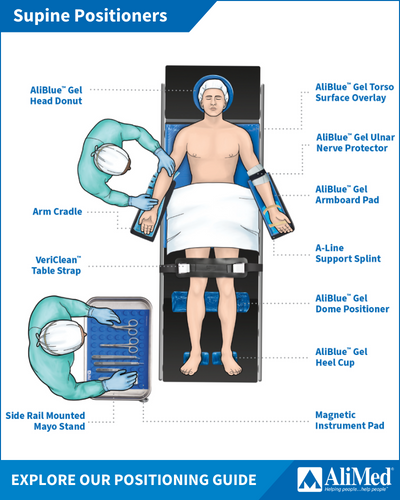-
Home
-
Proper Patient Positioning Guidelines: Supine Position
Proper Patient Positioning Guidelines: Supine Position
August 7, 2023

The supine position is the most common patient position in the operating room. It is often used for surgical procedures involving the head, neck, abdomen, and extremities, as well as many minimally invasive surgeries.
As with any surgical position, positioning a patient in supine, especially for longer periods of time, can place pressure on various parts of the patient’s body. These areas generally include the occiput, scapulae, thoracic vertebrae, olecranon processes, sacrum, coccyx, ischial tuberosities, popliteal area, and calcaneum. In addition to pressure injuries, other safety concerns during supine may include tissue or nerve damage or musculoskeletal injuries due to improper positioning.
In this article, we will review proper patient positioning techniques in supine to help prevent positioning injuries and some of the key surgical positioning products used to support and stabilize the patient while minimizing pressure risk, skin shear, and nerve injuries.
Positioning the Patient in Supine: Head and Neck
Note: Prior to positioning a patient for surgery, perioperative nurses or the surgical team initially perform a preoperative risk assessment so that all risk factors and any specific patient needs and requirements are identified to ensure safe positioning.
The patient is positioned flat on their back with the head elevated to align with the spine, keeping the neck in a neutral position. The head is typically supported by a patient positioning headrest such as AliMed’s AliBlue™ Gel Head Donut or Disposable Foam Head Donut. Head donuts help to offload pressure from the occipital protrusion.
Positioning the Patient in Supine: Arms and Upper Body
The arms are typically secured at the patient’s side using a draw sheet tucked under the patient or a table strap to minimize slipping. The palms face in against the patient and the elbows are padded, taking care not to hyperextend the elbows.
Arms may also be extended on armboards with the palms facing up. When armboards are used during patient positioning, the arms should be extended at less than a 90-degree angle from the body to prevent ulnar and radial nerve compression or brachial plexus injury. Arms can then be secured to the armboard with armboard straps.
For elbow protection, AliBlue Gel Ulnar Nerve Protectors wrap around the elbow, reducing shear while permitting access for A-lines or IVs. Armboard pads can help provide added anti-shear protection for the bicep, elbow, and forearm areas.
Positioning the Patient in Supine: Legs and Lower Body
The legs are positioned in a straight line with ankles uncrossed and knees flexed slightly at approximately 5 to 10 degrees without touching. Positioning the knees in slight flexion helps prevent popliteal vein compression and reduces the patient’s risk for Deep Vein Thrombosis (DVT). A soft positioner such as the AliBlue Gel Dome Positioner may be placed under the knees to reduce pressure while alleviating strain on the lumbar spine. A positioning strap is also placed above the knee and around the table for added stabilization.
The patient’s heels should be elevated off the underlying surface as this will increase perfusion and help prevent pressure injury. Heel Cup positioners are used to help protect against pressure and feature a slit in the back of the cup to safeguard the patient’s Achilles tendon.
To protect the patient’s back and sacral area, pads such as the AliBlue Gel Torso Surface Overlay may be placed under the lumbar area to prevent postoperative back strain, as it supports the patient’s physiologic lordotic curvature. Overlays also help reduce the risk of pressure injuries, skin shear, and extraneous movement during partial anesthesia procedures.
More Resources for Supine and other Surgical Positions
AliMed has a wide range of reusable and disposable surgical positioning products to aid with proper patient positioning while helping reduce pressure, shear, and nerve injuries during supine procedures.
Explore our interactive Supine Positioning Hub or browse our comprehensive guide for more patient positioning products and resources for supine and other common surgical positions, including lateral, prone, lithotomy, fowler’s, Trendelenburg, reverse Trendelenburg, and spinal.